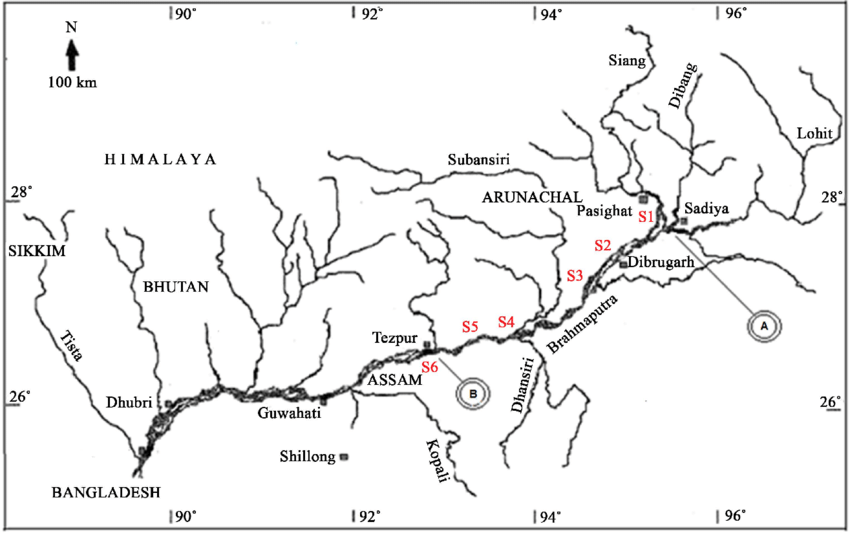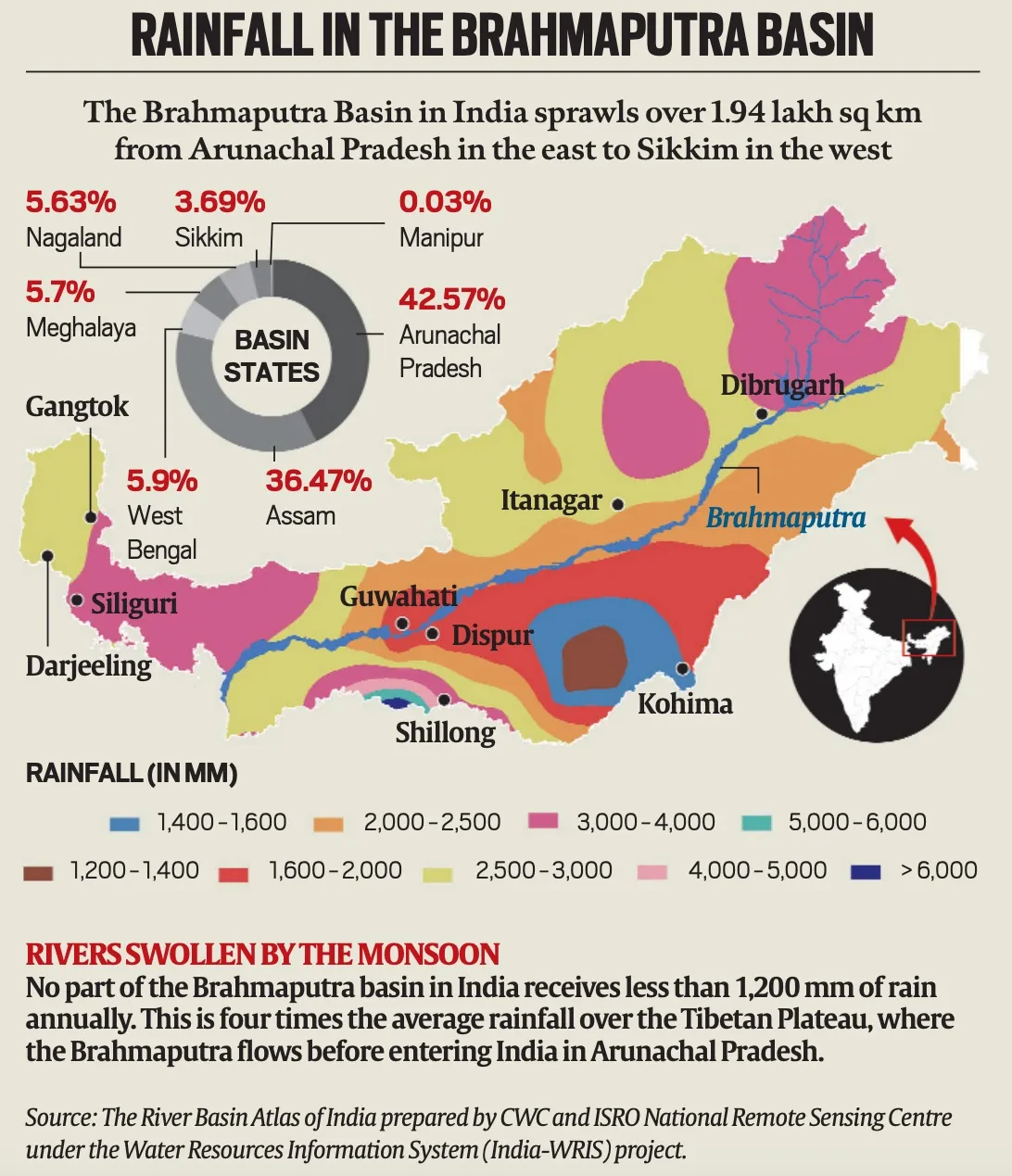China’s Brahmaputra Dams and India
Could Chinese dams affect Brahmaputra flow in India?
Context: As China advances its dam-building agenda on the Brahmaputra River (Yarlung Tsangpo in Tibet), concerns have grown in India and Bangladesh about possible impacts on downstream water flow.

More on News
- However, Assam Chief Minister Himanta Biswa Sarma has challenged what he calls Pakistan’s “scare narrative”, noting that 65–70% of the Brahmaputra’s water flow is generated within India, and that reduced flow from China may even help mitigate Assam’s devastating annual floods.
Where Does the Brahmaputra River Flow?
- Originating in Tibet as the Yarlung Tsangpo, the Brahmaputra flows eastwards before making a dramatic U-turn at the ‘Great Bend’ in Medog (Motuo), Tibet, entering India at Gelling in Arunachal Pradesh.
- Known as the Siang in Arunachal and Brahmaputra in Assam, it is joined by multiple tributaries before entering Bangladesh as the Jamuna.
What Dams is China Building on the Brahmaputra?
- India has been closely monitoring Chinese hydropower projects on the Brahmaputra.
- Most are run-of-the-river projects with limited water storage, located upstream and unlikely to impact water flow in Arunachal Pradesh or Assam significantly.
Medog Hydropower Project: A Mega Dam in the Making
- A key concern is China’s proposed Medog Hydropower Project near the Great Bend.
- With a reported capacity of 60,000 MW, it is set to become the world’s largest hydroelectric facility, three times the size of China’s Three Gorges Dam.
- While few technical details are public, early analyses suggest it may not feature large-scale water storage, reducing the risk of long-term downstream impact.
How Much Water Does India Contribute to the Brahmaputra?
- Despite Tibet covering 65.8% of the Brahmaputra basin, Indian territory contributes over 80% of the river’s total water yield, according to official Indian estimates.
- The primary reason is rainfall disparity:
-
- Tibet receives only about 300 mm of rainfall annually.
- Northeast India receives an average of 2,371 mm, with many areas getting more than 1,200 mm.
- Additionally, the river’s flow in India is heavily augmented by monsoonal rainfall and tributaries that contribute significantly to its volume, including snowmelt from Indian catchment areas.

Can Chinese Dams Reduce Brahmaputra’s Flow in India?
Given the Brahmaputra’s vast water yield in Indian territory, Chinese dams are unlikely to drastically impact downstream flow. However, concerns remain over:
- Lean-season water flow affecting Siang hydropower projects.
- Sudden releases from Chinese reservoirs triggering floods.
- Geophysical risks like landslides, dam failure, or earthquakes.
- India is exploring domestic storage solutions, like the Upper Siang Hydropower Project, to act as buffers against such flow variations.
How is India Harnessing the Brahmaputra’s Water Potential?
- The Brahmaputra system accounts for over 30% of India’s water resources and 41% of its hydropower potential, as per the CWC-ISRO Brahmaputra Basin Atlas.
- Yet, only limited hydropower development has occurred, mainly in Arunachal Pradesh.
- Progress has been slow due to challenges like: Forest land submergence, Land acquisition hurdles, Environmental and community concerns.
Proposed Inter-Basin River Links
India’s National Water Development Agency (NWDA) has suggested two major river-linking projects:
- Manas-Sankosh-Teesta-Ganga Link: connecting Brahmaputra tributaries to the Ganga.
- Jogighopa-Teesta-Farakka Link: linking the Brahmaputra at Jogighopa to the Farakka Barrage on the Ganga.
What Should India’s Strategy Be?
India must adopt a multi-pronged strategy to address the evolving situation:
- Conduct scientific studies to assess downstream impacts.
- Engage diplomatically with China for transparent data-sharing.
- Negotiate protocols for advance warning of floods or reservoir operations.
- Develop domestic water storage and early warning systems in flood-prone areas.
- Enhance satellite and ground-level monitoring of Chinese projects.
Could China’s Dams Affect the Sutlej and Indus Rivers?
China has developed hydropower projects on both the Sutlej and Indus Rivers, which also originate in Tibet. However:
- The Bhakra Dam (Gobind Sagar) in Himachal Pradesh can absorb flow variations on the Sutlej.
- On the Indus, India has minimal consumptive use, though run-of-the-river plants like Nimoo Bazgo in Ladakh could face minor disruptions.
While Chinese hydropower construction on the Brahmaputra does warrant close monitoring, it is important to differentiate facts from fear. With 80% of the river’s flow generated in India, the scope for upstream control is limited. India’s focus should now shift to scientific preparedness, diplomatic engagement, and strategic water resource management to secure its long-term hydrological and ecological interests
Subscribe to our Youtube Channel for more Valuable Content – TheStudyias
Download the App to Subscribe to our Courses – Thestudyias
The Source’s Authority and Ownership of the Article is Claimed By THE STUDY IAS BY MANIKANT SINGH



